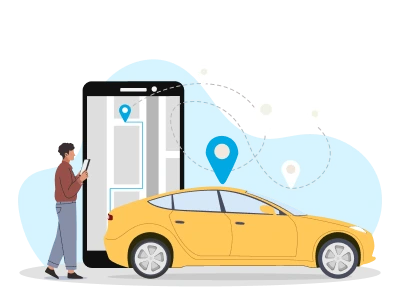Introduction
The ride-sharing industry is booming, and apps like Uber, Lyft, and Via have changed the way people travel. For startups and entrepreneurs, this growth has opened the door to launch their own ride-sharing platform with a Via Clone App.
A Via Clone App is a ready-made solution that comes with all the features you need—ride booking, real-time tracking, multiple payment methods, and an easy-to-manage admin panel. The best part? It can be customized to fit your business model and launched in just a few days.
But the key question is: how do you make money with a Via Clone App? That’s where revenue models come in. From driver commissions to in-app ads, there are several ways to maximize profit while keeping your users happy.
In this blog, we’ll explore the most effective revenue models for Via Clone Apps that can help you grow a successful ride-sharing business.
Commission-Based Revenue
One of the most widely adopted revenue models in the ride-sharing industry is the commission-based system. In this model, the platform charges a fixed percentage on every ride booked through the app. For example, if a customer pays $25 for a ride and the platform commission is 15%, the company earns $3.75 while the rest goes to the driver.
This model works because it ensures income on every successful trip. Drivers benefit from steady passenger demand without spending on marketing, while entrepreneurs generate predictable revenue without managing a fleet of vehicles. It’s a structure where both sides win.
For startups, this approach is particularly attractive. You don’t need massive upfront investment or complex business infrastructure. As long as rides are happening, money flows in. This makes it easier for new businesses to enter the competitive market with lower financial risk.
The commission model is also highly scalable. Whether you’re running your Via Clone App in one city or planning to expand globally, the system adapts naturally. More rides mean more revenue. Plus, you can set different commission rates depending on service type—like charging higher fees for luxury rides and lower for shared or corporate bookings.
Flexibility is another big advantage. Entrepreneurs can adjust commission rates to balance profitability and driver satisfaction. This adaptability helps in building long-term partnerships with drivers while ensuring sustainable earnings.
Overall, the commission-based revenue model provides a stable foundation for startups and enterprises alike. It offers steady growth, scalability, and predictability, making it one of the most reliable ways to monetize your Via Clone App.
Surge Pricing Model
Surge pricing, also known as dynamic pricing, is one of the most powerful ways to maximize revenue in the ride-sharing business. It adjusts ride fares automatically based on real-time demand and supply conditions, especially during peak hours or in high-demand zones.
When more riders are requesting trips than available drivers, the system increases prices. This not only helps balance demand but also encourages more drivers to get on the road, ensuring quicker service for passengers.
Dynamic Pricing During Peak Hours
During busy times such as office rush hours, late-night weekends, or special events, surge pricing can significantly increase revenue. Passengers pay slightly higher fares for guaranteed rides, while drivers earn more for their time and effort. This model ensures that the platform continues to function smoothly even under heavy demand.
Maximizing Earnings for Operators and Drivers
The biggest advantage of surge pricing is that it benefits both drivers and platform owners. Operators earn higher commissions from increased fares, while drivers enjoy greater income opportunities. This dual benefit makes surge pricing a sustainable revenue model that motivates drivers and keeps customers satisfied with faster ride availability.
By integrating surge pricing into your Via Clone Script, startups and enterprises can maintain service efficiency, improve driver retention, and ensure consistent revenue growth—even during fluctuating demand cycles.
Subscription Plans for Drivers
Another effective way to monetize a Via Clone is through subscription plans designed specifically for drivers. Instead of relying only on commission, drivers can pay a fixed fee—weekly, monthly, or quarterly—to access the platform and receive ride requests.
This Via revenue model works particularly well for full-time drivers who prefer predictable costs over fluctuating commission rates. By paying a flat subscription, they can keep 100% of their trip earnings, which motivates them to stay loyal to the platform.
Weekly and Monthly Subscriptions
Platforms can offer flexible subscription packages based on driver needs. For example, part-time drivers may prefer a weekly pass, while regular drivers might choose a monthly plan for better savings. This variety ensures that drivers can select what suits their work style best.
Recurring Revenue and Stability
For entrepreneurs, the subscription model brings recurring revenue and long-term stability. Since fees are collected upfront, startups can forecast income more accurately and plan growth strategies with confidence. It reduces dependency on daily ride volume and creates a more balanced revenue stream.
Overall, subscription plans are a win-win model. Drivers enjoy higher earnings potential without commission cuts, while operators benefit from a steady, reliable income source. This dual advantage makes subscriptions a powerful add-on to the traditional commission-based approach.
In-App Advertising Revenue
One of the most overlooked yet highly profitable revenue streams for a Via Clone App is in-app advertising. Instead of relying only on rides and commissions, you can monetize the platform by offering ad space to local businesses, brands, or service providers who want to connect with your growing user base.
Advertising inside a ride-hailing app feels natural because users regularly engage with the app for bookings, payments, and updates. This provides an opportunity to display targeted promotions without being intrusive.
How It Works
Banner Ads – Place small banners on the app’s home screen, booking page, or payment confirmation screen. These ads get high visibility since users interact with these areas frequently.
Sponsored Listings – Local businesses, such as restaurants or retail shops, can pay to appear as featured partners within the app. This works especially well when combined with ride destinations.
In-App Pop-Ups or Offers – Promote special discounts, deals, or coupons from partner companies. For example, a rider booking a trip to a mall may see a coupon for a store at that location.
Benefits for Startups and Businesses
- Recurring Income: Advertising provides a steady flow of revenue that doesn’t depend on the number of rides alone.
- Partnership Opportunities: Collaborating with local businesses builds strong community connections while generating income.
- User Value Addition: Riders can benefit from exclusive offers, making the app more engaging and rewarding to use.
For startups, in-app ads are a low-risk, high-reward model that complements traditional ride-sharing revenue. As the user base grows, advertising potential multiplies, creating a sustainable and scalable income stream.
Ready to Build Your Own Via Clone App?
Turn your ride-sharing idea into a profitable business with White Label Fox’s Via Clone App.

Corporate Tie-Ups & Bulk Contracts
Another powerful revenue stream for a Via Clone App is building corporate partnerships. Many companies, especially in IT, finance, and manufacturing, require reliable employee transportation. Instead of managing their own fleet, they often tie up with ride-sharing platforms to ensure safe and timely commutes.
By offering corporate contracts, your platform can secure long-term, bulk bookings that guarantee consistent revenue. This model not only benefits businesses but also creates a predictable income stream for operators.
How Corporate Partnerships Work
Employee Commute Solutions – Companies sign a contract to provide daily pick-up and drop-off services for staff.
Bulk Ride Discounts – Special pricing is offered for large volumes of bookings, ensuring affordability for businesses.
Dedicated Fleet Options – Operators can assign a specific fleet or driver group exclusively for a company.
Flexible Billing Systems – Instead of per-ride payments, companies receive monthly or quarterly consolidated invoices.
Benefits of Bulk Contracts
- Predictable Revenue: Unlike individual ride bookings, corporate tie-ups ensure steady monthly income, reducing dependency on daily fluctuations.
- High Volume of Rides: Corporate deals bring a consistent flow of passengers, especially during office hours.
- Stronger Market Position: Partnering with well-known companies enhances your platform’s credibility.
- Driver Benefits: Steady bookings mean drivers get guaranteed trips and income, improving retention.
For startups and entrepreneurs, this model is a game-changer. It ensures recurring revenue, creates trust with corporate clients, and makes scaling much easier. By integrating corporate ride options into your Via Clone App, you open the door to sustainable B2B growth.
Conclusion
A Via Clone App is more than just a taxi booking solution—it’s a strategic investment for entrepreneurs who want to diversify income streams and tap into the fast-growing ride-hailing market. With ready-made features, customizable branding, and quick launch timelines, you can establish a sustainable business without months of development delays.
At White Label Fox, we specialize in delivering fully white-labeled Via Clone Apps that are ready to launch in just a few days. Our solutions help startups and enterprises build scalable transport businesses with ease.

















